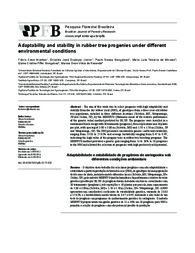Adaptability and stability in rubber tree progenies under different environmental conditions.
Adaptability and stability in rubber tree progenies under different environmental conditions.
Author(s): ARANTES, F. C.; SCALOPPI JUNIOR, E. J. S.; GONÇALVES, P. S.; MORAES, M. L. T. de; GONÇALVES, E. C. P.; RESENDE, M. D. V. de
Summary: The aim of this work was to select progenies with high adaptability and stability from the dry rubber yield (PBS), of genotypes from a three-year-old rubber tree population, installed in three different locations (Selvíria, MS, Votuporanga, SP and Colina, SP), by the MHPRVG (Harmonic mean of the relative performance of the genetic value) method predicted by BLUP. The progenies were installed in a randomized block design with 30 treatments (progenies), three replications and 10 plants per plot, with spacing of 3.00 x 3.00 m (Selvíria, MS) and 1.50 x 1.50 m (Colina, SP and Votuporanga, SP). The PBS presented considerable genetic coefficient variability, ranging from 23.03 to 27.82% and average heritability ranging from 0.47 to 0.99, indicating the high value of the progeny tests in rubber tree breeding programs. The MHPRVG method provided a genetic gain ranging from 11 to 38% in 10 progenies to the PBS and allowed the selection of progenies with high predicted yield potential.
Publication year: 2013
Types of publication: Journal article
Unit: Embrapa Forestry
Keywords: Genetic selection, Hevea Brasiliensis, REML/BLUP, Seleção Genética
Observation
Some of Embrapa's publications are published as ePub files. To read them, use or download one of the following free software options to your computer or mobile device. Android: Google Play Books; IOS: iBooks; Windows and Linux: Calibre.
Access other publications
Access the Agricultural Research Database (BDPA) to consult Embrapa's full library collection and records.
Visit Embrapa Bookstore to purchase books and other publications sold by Embrapa.

